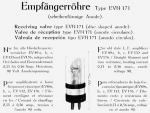
EVN171
|
|
|||||||||||||||||||||||||||||||||||||||||||
|
Hits: 1174 Replies: 3
How to determine age of a Telefunken EVN171 tube
|
|
|
Kenneth Faiver
31.Jan.21 |
1
Greetings I have an old Telefunken EVN171 tube. On the bulb is printed the following inscription: "TELEFUNKEN DRP TYPE EVN171 N91900/4." The final 4 characters "00/4" are difficult to read clearly. The tube has a plain brass base with four identical pins, spaced as on a UX tube. In the bottom of the base, centered between the 4 pins, is a larger hole, approximately 3/16 inch or 4.5 millimeters in diameter. The tube has an intact filament, but the bulb is loose on its base. I am wondering if anyone knows how to identify (or estimate) the date of manufacture of this tube, given the information I have been able to supply. It is my intention to sell the tube and I would like to be able to estimate its value. Thank you. I appreciate any help or advice you might be able to offer. Ken Faiver W8HNI
|
|
Nikolaus Löwe
31.Jan.21 |
2
The EVN171 was introduced in late 1916. My tube with serial Nr. 36401/6 was tested May 1917, Nr. 82358/8 was tested Aug. 1917. By 1918 the improved successor type EVE173 was being manufactured in quantities, which left to the EVN171 the role of spare part only. It's a safe guess an EVN171 with Number 91900 would have been made in late 1917 or early 1918. If your tube has a base with four identical pins, I strongly suspect it's not the original one. This would also explain why the tube is loose, which is not common for these tubes, which were cemented into their base. To be certain, I'd have to see a picture. The retail value of the tube would be clearly affected by the wrong base. Yours, Nikolaus Löwe |
|
Kenneth Faiver
01.Feb.21 |
3
Dear Nikolaus Thank you for the clear and helpful response. Your suspicion may be correct, that possibly this tube has been attached to a different base. That would explain why the pinout connections do not match what I have seen in the literature. My guess is that the owner, instead of obtaining or making a suitable adapter base, simply removed the base from the bulb and replaced it with an old UX brass base to make it compatible with an existing piece of equipment. Instead of this typical pinout: P O F o o F o G my pinout is like this, and also has a bayonet pin (BP): BP o o
F O O F The filament does light up. I applied 1.5 volts to pins #1 and #4 and it glowed nicely red. On closer inspection, these pins are both slightly larger diameter than pins #2 and #3. Moreover, the brass base has straight sides, unlike the EVN171s that I see in the pictures. Given this understanding, do you think imy tube has any value or what it might be worth to a collector? I have attached some photos, I don't know the source of this tube, but I had accumulated several hundred vacuum tubes in my 70 years as a radio amateur, and this was among them. My father had his doctorate in electrical engineering and built some broadcast receivers during the 1920s. This could have been one of his -- or not. Thank you for your time and thoughtfulness. Best wishes and good health. Ken Faiver
llll
Attachments
|
|
Nikolaus Löwe
01.Feb.21 |
4
Dear Ken, the tube base has definitely been replaced, but in a thoughtful way. This is still a rare tube, with good filament and usable vacuum (the filament would have burned out during testing if there was air in the bulb). While this is not the place to discuss prices, and it very much depends on the country in which you are trying to sell this tube, I think you could maybe compare it to a VT-1. The VT-1 was made about the same time, but in much larger numbers. Your much rarer EVE171, on the other hand, has been re-based. Something like this might be the basis for a fair trade. Yours, Nikolaus Löwe |
End of forum contributions about this tube
| Data Compliance | More Information |




